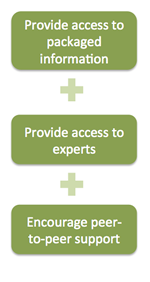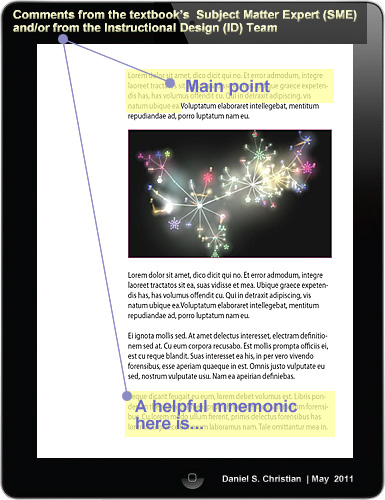



101 quick ideas to ignite your online learning community — from Bloomfire.com by Josh Little and Nehemiah Chu
Excerpt:
Our quick start guide to starting your online learning community (or taking your existing one to another level). Includes community management tips touching on contests, awards, prizes, recognition, and internal marketing.
From DSC:
I hesitated in posting this because I don’t know what the future will tell us re: the use of wireless technologies. But for now, the majority of the tests/research that I’ve seen assert that we are not in much danger from using wireless technologies. (I just hope this arena doesn’t turn out to be another Philip Morris type of move from the manufactures/companies selling these items.)
Why we need less instruction — from Clive on Learning by Clive Sheperd
Excerpt:
Another reason you might back away from instruction as a strategy is because it is more efficient to provide how-to materials at the point-of-need – it isn’t learning that’s required, it’s performance support:

From DSC:
I originally saw this at:
Excerpt:
Of course, the future belongs to the young. You get a decent look at it ahead of time, though, by watching how they build new ways seize it.
Earlier today a 17 year old named Priyanka Jain launched a student run nonprofit called iCAREweCARE, which is dedicated to helping high school and college students identify causes they care about, find local organizations that address those problems, and then write about their experiences, or connect with their friends over them. There is a Web site, and Facebook connections for rapid and deep information sharing.
The cause-centered orientation is praiseworthy. The implications of this kind of social platform, however, could be what proves really world-changing
[Concept] The new “textbook”: A multi-layered approach — from Daniel S. Christian
I’ve been thinking recently about new approaches to relaying — and engaging with — content in a “textbook”.
For a physical textbook
When opening up a physical textbook to a particular page, QR-like codes would be printed on the physical pages of the textbook. With the advent of augmented reality, such a mechanism would open up some new possibilities to interact with content for that page. For example, some overall characteristics about this new, layered approach:

For an electronic-based textbook


Advantages of this concept/model:
Addendum (5/26):
MyTVBuddy kicks off as the first pan-European Social TV app on iPad — from appmarket.tv (emphasis DSC)
Excerpt:
Today E-ZONE unveiled its iPad app MyTVBuddy claiming it takes Social TV to the next level of exploration, interaction, engagement and participation by letting users check in to TV programs, watch videos, post messages on Facebook, share Twitter messages, participate in conversations and see where other users are located. MyTVBuddy kicks off with a special launch edition of Eurovision 2011.
MyTVBuddy comes with a solution for turning TV viewing into a social experience by using mobile devices such as the iPad. According to a recent study from Yahoo, nearly 90 percent of people watching television are using a mobile device at the same time. Be it Twitter, Facebook, email or instant messaging, they are doing more than just watching.
From DSC:
TV and entertainment coming up to bat — with learning-related applications on deck! 🙂
Also see:
Also see:
Also see:
From DSC:
Check out the topics:
Social Learning Examples – in the Workplace — from the Centre for Learning & Performance Technologies by Jane Hart
100+ Examples of the use of Social Media in Learning — from the Centre for Learning & Performance Technologies by Jane Hart
Addendum:
Study: 30% of all US households already have TV connected to Internet
 New consumer research from Leichtman Research Group, Inc. (LRG) finds that 30% of all households have at least one television set connected to the Internet via a video game system, a Blu-ray player, and/or the TV set itself — up from 24% a year ago. Overall, 10% of all adults watch video from the Internet via one of these devices at least weekly, compared to 5% last year. This increased usage is heavily driven by Netflix subscribers, with 30% of Netflix subscribers watching video from the Internet via one of these connected devices weekly, compared to 3% weekly use among all non-Netflix subscribers.
New consumer research from Leichtman Research Group, Inc. (LRG) finds that 30% of all households have at least one television set connected to the Internet via a video game system, a Blu-ray player, and/or the TV set itself — up from 24% a year ago. Overall, 10% of all adults watch video from the Internet via one of these devices at least weekly, compared to 5% last year. This increased usage is heavily driven by Netflix subscribers, with 30% of Netflix subscribers watching video from the Internet via one of these connected devices weekly, compared to 3% weekly use among all non-Netflix subscribers.
Also see:
Addendums:
From DSC:
Why post this? Because:
New Sony TV Ad: Television Redefined, Internet TV, 4/15/11 — from electrictv.com
New Samsung Smart TV Ad: Internet TV, 4/13/11 — from electrictv.com
[WATCH]: Interactive Video Conferencing at NCSSM